CNC Tube Bending Services – What Are They?
Introduction
Metal workers in the past had to use manual bending tools and old bending process to shape tubes of varying diameters and bad angles, wrong measurements and other faults in presentation were common results of such activities.
Thankfully, that time is long gone. Machines built for this purpose allow us to bend to precise specifications. These tools are referred to as CNC tube bending machines and due to its precision, numerous related industries have flourished.
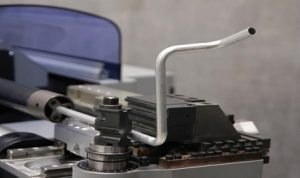
What Is CNC Tube Bending?
The process of bending tubes using a CNC machine which is automated and controlled by computer is known as CNC tube bending. CNC tube bending relies on powerful moving parts powered by electric motors or, in some cases, a hydraulic systems. CNC tube benders can make complex bends with a level of accuracy that can’t be matched by hand-formed parts.
In a CNC tube bending project setup, the computer manages the hydraulics and mechanical components. The use of CNC for the bending of tubes ensures that the bends will be constant and that the volume and other dimensions will be accurate. Additionally, it removes any uncertainty that may have been present regarding bending procedures, each and every time.
Benefits of Using CNC Tube Bending
With the advancement of technology, CNC tube bending machines have surpassed their manual counterparts in all aspects of tube bending and capabilities and comes with so many advantages, some of them are
It Saves your cost
CNC tube bending is a cost-effective option to think about if you’re trying to keep prices down without sacrificing quality.
It saves your time
A lot of the work is automated by the machine, so considerably less human effort is required, speeding up the process.
Reliability in Both Quality and Consistency
The use of a computer numerical control (CNC) bender not only ensures a high-quality end result, but also allows the service provider to replicate that quality result reliably.
Types Of CNC Tube Bending Processes
CNC tube bending can make a variety of bends. The high levels of output and consistency they provide are guaranteed by the precision of CNC tube bending. To form intricate tubular shapes, CNC tube benders are useful because of their ability to automatically regulate the pipe and position it precisely. Let’s take a look at the few of the important CNC tube bending methods.
Press Bending
When it comes to the manufacturing of tubes, press bending is one of the oldest techniques still in use. To create the bend, the tube is held in place at two locations, and a ram is then pressed against the tube to form it.
The bend characteristics to be imposed on the tube are provided by the external dimensions of the cylindrical ram.
Rapid and tidy, press bending is ideal for symmetrical components. A smaller degree of bend, however, can be difficult to achieve with this procedure. It doesn’t provide any internal reinforcement for the tube, therefore it can bend in both directions.
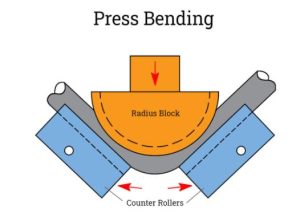
Rotary Draw Bending
When it comes to making bends with consistent diameter and CLR that result in little ovalization, rotary draw bending is the way to go. Pipe fittings, handrails, instrument tubing, automobile and aerospace components, and so on are all common places to see this method in use.
This technique is also applied to hollow parts with non-circular cross-sections. When the appropriate tools are used for the task at hand, a bend can be made that is both smooth and aesthetically beautiful in its variety of forms.
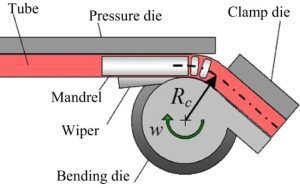
Roll Bending
The roll bending also known as an angle bending, is another bending method. When you need a bend with a huge radius, say eight times the diameter of the pipe or tube, you utilize this method.
To handle tubes and pipes, the machine has spherical tooling. Getting equipped doesn’t cost much. Just three rollers are required. The tube or pipe radius is determined by where the central roll is located.
Mandrel Tube Bending
A method known as mandrel bending is one in which a steel rod is put into the metal tubing while it is being bent. The tube can be bent to perfection with this method, and the tube will not wrinkle or break at the spot where it is bent.
The bending of thin tubing without any deformities on an extremely tight radius can be accomplished with the help of a machine known as a CNC tube bender, which is also used to execute mandrel bending of tubing.
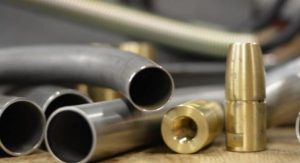
Bending material types
Aluminum
The utilization of specialized expertise and forming procedures is required to prevent cracking or collapsing when bending tubes made with aluminum, despite the shortcomings, the material’s widespread availability and low cost making it a popular material for creating tubes for a wide range of applications.
Alloy Steel
Steel tubes made with various alloys, including aluminum, manganese, titanium, and tungsten, have been developed. These have a high level of durability, resilience, and toughness.
It’s malleable enough to be shaped into circles, rectangles, and squares. To keep up with the rising demand and many industrial uses for steel tubing, many tons are manufactured every year.
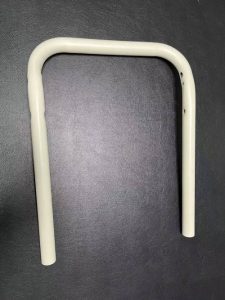
Stainless steel
Stainless steel tube is used in CNC machining for the automotive sector to create quiet, effective mufflers. This is due to the fact that they are strong enough to endure the enormous pressure that runs through them.
It is also used in the construction of solar panel frames, machinery, electrical wiring, and medical tools. The versatility of steel tubing comes from its malleability, which allows it to be formed into a wide range of forms and wall thicknesses.
Titanium
Tubes made of titanium are used to construct everything from oil rigs to racecars to airplanes. The considerable strength offered by these tubes is the primary benefit that makes them ideal for this use.
Titanium tubes, when properly constructed and welded, are what keep people safe in situations like driver safety. Tube bending is used to modify tubes for use in a wide range of applications.
Brass
Brass, unlike its aluminum and copper counterparts, does not rust. This property is good for marine applications, where it is commonly employed.
In addition, brass never needs to be refinished or maintained. You’ll frequently find its dark, lustrous color on doorknobs, railings, and other interior accents. Brass is non-sparking, too, making it safe around volatile gases.
These aesthetics and features at a price, though. Brass is pricey. It’s a pretty soft metal, too, which might provide issues for bending, rolling and manufacturing.
Common Uses of CNC Tube Bends
There is a wide variety of uses for CNC tube bends in both commercial and residential system settings. When it comes to bending pipes, a CNC tube pipe bending machine is your best bet.
Products for both the home and the office can be manufactured with the same set of tools. Because of its versatility, a pipe bending machine can be a crucial piece of equipment and can give you maximum support to the team in your company.
Here are a few areas it is put to use:
- Heavy industry
- Ship construction
- Trucking
- Products or Equipment Production
- Goods for consumers
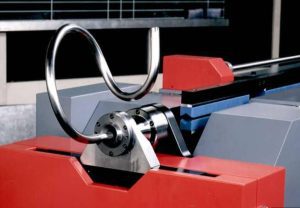
Conclusion
The term ” CNC tube bending” refers to a set of manufacturing procedures which are automated and controlled by computer for modifying the shape of a tube or pipe to achieve a certain geometry or set of features like round form from outside or the round wall from inside of the tube or square or any other custom desired shape.
Given how capable it is over more conventional methods, it is finding use in a wide range of customers in various fields.
Worthy Hardware is a CNC manufacturing and sheet metal fabrication company,including CNC machining services,CNC milling services, CNC turning services, laser cutting services and stamping services.Call us +86-76989919645 or email us [email protected] for more discounts for your projects.

